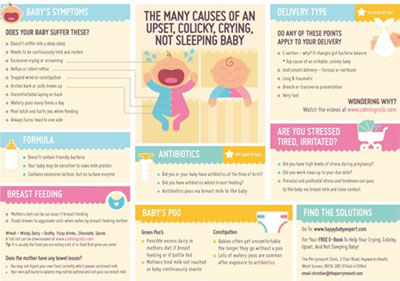
Your delivery type changes the good bacteria in your breast milk
This piece of research isn’t included in my book Calming Colic but I think it will be if I do an updated version at some point. It will certainly be influencing my treatment of colicky babies in my clinic.
To summarise the research I have pasted below:
- The bacteria that is present in a mothers breast milk is different according to the type of delivery she had for her baby
- The bacteria is different in normal weight and over weight mothers (over weight have less diversity)
- The bacteria is different in mothers breast milk who had a vaginal delivery, elective c-section and scheduled c-section
Why is this important?
In Calming Colic I revealed that colic can be caused by bacterial imbalance in the newborns digestive system. A major influence in this is if the mother had a c-section, the research now shows that not only does the baby have altered gut bacteria but the mothers breast milk does too!
It was also revealed that stress altered the babies gut flora, perhaps from a traumatic birth or c-section and now this research shows that a stressful emergency c-section alters the bacteria in the mothers breast milk!
Fascinating research that confirms again my approaches for Calming Colic
https://www.calmingcolic.com/index.html
http://www.amazon.co.uk/dp/B009S8ZNLG
The human milk microbiome changes over lactation and is shaped by maternal weight and mode of delivery
Raul Cabrera-Rubio, M Carmen Collado, Kirsi Laitinen, Seppo Salminen, Erika Isolauri, Alex Mira
Breast milk is recognized as the most important postpartum element in metabolic and immunologic programming of health of neonates. The factors influencing the milk microbiome and the potential impact of microbes on infant health have not yet been uncovered.
OBJECTIVE: Our objective was to identify pre- and postnatal factors that can potentially influence the bacterial communities inhabiting human milk.
DESIGN: We characterized the milk microbial community at 3 different time points by pyrosequencing and quantitative polymerase chain reaction in mothers (n = 18) who varied in BMI, weight gain, and mode of delivery.
RESULTS: We found that the human milk microbiome changes over lactation. Weisella, Leuconostoc, Staphylococcus, Streptococcus, and Lactococcus were predominant in colostrum samples, whereas in 1- and 6-mo milk samples the typical inhabitants of the oral cavity (eg, Veillonella, Leptotrichia, and Prevotella) increased significantly. Milk from obese mothers tended to contain a different and less diverse bacterial community compared with milk from normal-weight mothers. Milk samples from elective but not from nonelective mothers who underwent cesarean delivery contained a different bacterial community than did milk samples from individuals giving birth by vaginal delivery, suggesting that it is not the operation per se but rather the absence of physiological stress or hormonal signals that could influence the microbial transmission process to milk.
CONCLUSIONS: Our results indicate that milk bacteria are not contaminants and suggest that the milk microbiome is influenced by several factors that significantly skew its composition. Because bacteria present in breast milk are among the very first microbes entering the human body, our data emphasize the necessity to understand the biological role that the milk microbiome could potentially play for human health.



No Comments